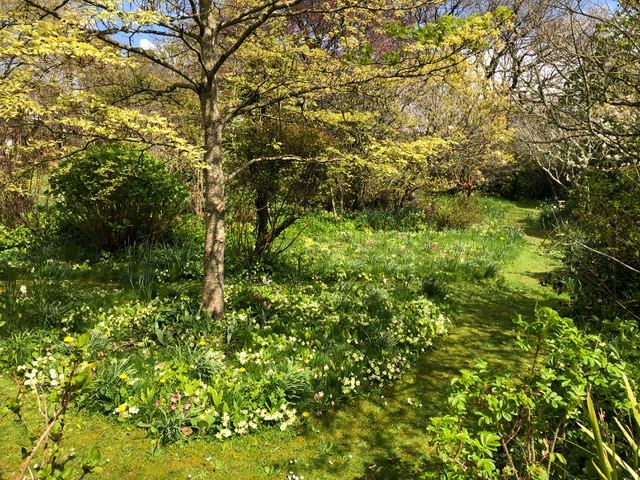Shira Rüb and Richard Lemon
Lower Ashton, Devon
A former pony paddock, now with over 108 species of plants recorded
Spara Bridge Meadow, Lower Ashton

We bought this long 4 acre meadow in 2008. It is bordered on one side by the River Teign and the other by the Teign Valley road. Until about 2004 it had been used to graze horses and subsequently by an elderly woman who set about planting a few trees and removing an area of top soil to scatter poppies, corn cockles, and ox eye daisies for a fenced wildflower area.
We took out the fencing and only the ox eye daisies now remain. We brought to the surface a stream, bisecting the meadow, which for over a century had entered the field only to disappear immediately into an underground culvert and emerge at other side straight into the river. This is now lined with alder, hazel and birch, all self-seeded, and is beginning to show its preferred meandering course. In the drought this year, for the first time, the stream dried up from early August until the end of September.
When we took over the meadow our aim was to give plants that had been suppressed by vigorous grasses or grazed down by the horses a chance to emerge.
Soon after the grass had been cut for hay that first summer we scattered yellow rattle gathered from a local meadow. Although only a few areas were sown in this way it appeared that pretty much every yellow rattle seed germinated and 14 years on it continues to thrive, forming a significant but not overwhelming part of the flora.
In the summer of 2021 hay from our meadow was used to seed another on a farm the other side of the river. A botanical survey of Spara Bridge Meadow yielded a list of 108 wildflower species.
Southern Marsh and Common Spotted orchids appeared early on whilst Corky-Fruited Water Dropwort and Pignut are more recent arrivals. The river boundary has some ancient woodland indicators including ramsons, wood anemones, bluebells, sanicle, and wild daffodils, the latter increasingly taking the opportunity to spread into the meadow.

We have also planted an orchard, which we have fenced to protect from the deer, of which Ashton has a significant over-population problem. We have found that a gadget with a motion sensor that triggers a light and radio when an animal approaches is a fairly good deterrent and the avenues of trees we have planted inside the road boundary have done pretty well.
Within the orchard and around the perimeter we mow paths providing some variety of short and long grass habitats. Violet oil beetles are numerous on the riverside path in spring.
For those interested in fungi, a large number of Parasol mushrooms and the occasional Pink Ballerina waxcaps have been seen, and a most incredible (and smelly) Octopus Stinkhorn appeared on a mown path this year.

We usually have the meadow cut as late as possible but this summer with the drought the farmer had put away his hay-making gear early and we missed the opportunity. As the farmer has been less keen on the more diverse hay mix, we have had some neighbours scythe parts of the meadow, but this is hard work for them and for us as we have to rake it up. Next year we aim to line up a cut (modern method) by the end of August, though of course weather will be in charge as always.
Other "Me and my Meadow" stories

Mike and Gill Cunniam
Holne, Dartmoor
A one acre garden nature reserve - wood meadow, pond, plants for pollinators, bird and bat boxes. All helping to attract a lot more insects and bird life

Charlotte Parton and David Jenkinson
Broadhempston
The creation of a garden wildlife haven - a new wildflower meadow and nature pond, starting from scratch.

Bronwen & Martin Gundry
Blackdown Hills AONB
A 38 acre farm with a variety of habitats, including unimproved pastures and hay meadows

Julian Pady and Alison Andrews
Goren Farm, Honiton
Goren Farm has been in the family since 1955 and was farmed as an extensive dairy farm up until 1990. Since then the fields have been set to hay meadows to develop a natural balance with nature
